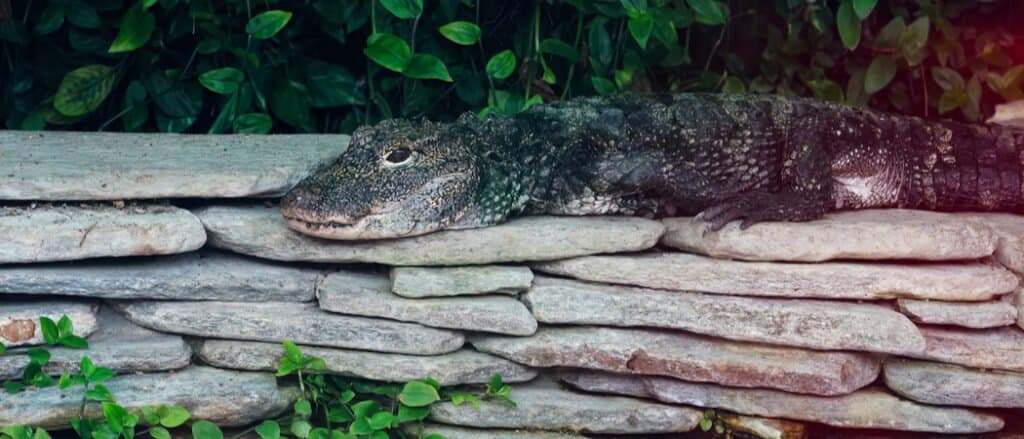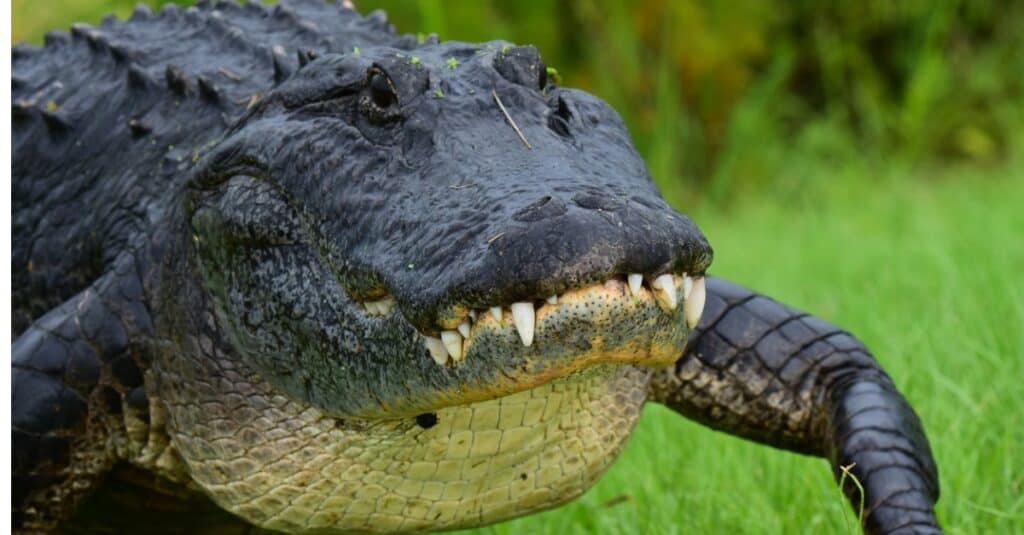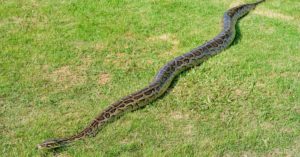Key Points:
- Alligators inhabit many states in the southern U.S. from Florida to North Carolina, and westward to Texas. Southern Alabama does have alligator infested lakes, and there are increasing reports of sightings in northern Alabama.
- The habitat of the alligator for an alligator is freshwater lakes, rivers, streams, and marshlands.
- Practice caution in areas where alligators might live. Never approach or feed a wild alligator, nor swim in alligator-infested lakes.
The southern United States might not be home to king cobras, polar bears, or koalas, but it is home to the famous American alligator. Alligators are one of the most popular tourist attractions in Alabama. You can even visit a place called Gator Alley in this southern state. But, if you’re looking to take a dip in one of Alabama’s beautiful lakes, you might want to think twice before taking the plunge. Alabama just might be home to some of the most alligator-infested lakes in the world.
Here, we’ll discover just about everything there is to know about alligator-infested lakes in Alabama. We’ll go over the alligator’s appearance, behavior, and life cycle. Then, we’ll take a closer look at the alligator’s favorite foods and how they hunt them. After that, we’ll go over just where you can find alligators in Alabama and what you need to do to stay safe around them.
Read on to learn more about alligator-infested lakes in Alabama!
Are There Alligators in Alabama?

There are only two types of alligators in the world: the American alligator and the
Chinese alligator
.
©HWall/Shutterstock.com
If you’re not from the southern United States, it might seem strange to think about gigantic, semi-aquatic, carnivorous reptiles living in waters. But, it’s true: there are alligators in Alabama. In fact, alligators can be found everywhere, from Florida in the southeast to North Carolina and Texas in the north and west (respectively).
Alligators stick primarily to the freshwater lakes, rivers, streams, and marshlands of southern Alabama. But, there are increasing reports of alligators in the northern half of the state. If you’re looking for alligator-infested lakes in southern Alabama, you likely won’t have to look too hard.
Are There Crocodiles in Alabama?
While Alabama is home to the infamous, at times terrifying, American alligator, crocodiles are completely absent. Both alligators and crocodiles are ‘crocodilians,’ thanks to their shared Order, Crocodilia. However, the largest crocodilians in the world, the Nile and saltwater crocodile, are not found in Alabama. In fact, they’re not native to North America at all. The only species of crocodilian native to Alabama is the American alligator. If you’re looking for another crocodile in the United States, you’ll have to look to South Florida where a population of about 2,000 American crocodiles lives in the Everglades.
Where to See Alligators in Alabama

Tourists come from all over the world to see alligators in Alabama.
©Robert Gregory Griffeth/Shutterstock.com
The short answer is that alligators are mostly found in southern Alabama. The one exception would be Wheeler National Wildlife Refuge. In that location, a small group of alligators lives along the Tennessee River. How did one small group of alligators survive in an isolated area far from their southern neighbors? In 1979 alligators were an endangered species, and an effort was made to expand their range. 56 alligators were dropped off in the refuge. However, the location is far enough north that hatchlings struggle to survive the winters and the population hasn’t expanded significantly.
In the southern half of Alabama, there is an estimated population of about 70,000 alligators. They live along rivers such as the Conecuh/Escambia and Perdido and also in lakes such as Lake Eufala, Lake Forest, or Big Creek Lake. They can be found across any wetland areas or marshes that are common in coastal regions.
if you want to see an alligator in Alabama, you have several excellent options. First, tourist attractions like Alligator Alley and Gator Boardwalk promise viewing of not just one but many alligators. If you’re more adventurous, check out some of the alligator-infested lakes in the southern half of the state. Just remember: don’t go swimming with alligators, and never feed or disturb them.
Species Profile: Alligator

Alligators get their name from the Spanish “el lagarto,” which means “the lizard.”
©iStock.com/cturtletrax
Alligators are the largest reptiles in North America. The biggest can grow up to 15 feet long and weigh nearly 1,000 pounds. Males are slightly bigger than females. They have long, scaly bodies and relatively short legs, with lengthy, powerful tails. Alligators are dark green-brown on their sides and backs and pale tan on their bellies. Like crocodiles, they have mouths full of teeth designed for grabbing and holding onto prey. When alligators close their mouths, only their top teeth remain visible.
Alligator-infested lakes in Alabama are generally home not only to adult alligators but to babies as well. Females build nests along permanent sources of water. Once they’re ready, they lay their eggs in these nests. Female alligators will aggressively guard their nests and even their young. Young alligators face threats from just about everything, including catfish, bigger alligators, eagles, snapping turtles, and feral pigs.
What Do Alligators Eat?
Alligators are obligate carnivores. This means that they need only meat to survive, and they’re excellent hunters. Alligators wait for prey in the water; they can remain submerged for up to an hour. Once some unlucky creature such as a fish, turtle, rat, deer, or bird crosses their path, the alligator lunges in one quick strike.
Staying Safe Around Alligators in Alabama

It is important to remember to stay safe around these incredible predators.
©Sorbis/Shutterstock.com
Seeing an alligator in the wild is one of the most incredible experiences you can have in Alabama. But, if you do see one, remember: alligators are wild animals and should be treated with respect and caution. Never approach or feed a wild alligator and never swim in alligator-infested lakes. If you find a nest or see a baby alligator, do not disturb it, as it’s likely the mom is nearby.
The Biggest Alligator Ever
American Alligators can grow to be quite large, depending on their location and gender. On average, adult male alligators measure around 11 feet in length and weigh 500-600 pounds. The largest American Alligator ever recorded was found in Louisiana and measured a whopping 15 feet 5 inches long! Female alligators are typically smaller than males, growing up to 8 or 9 feet in length. It’s not uncommon for some female alligators to reach 10 or even 11 feet long, though! Despite their size, American Alligators are surprisingly agile swimmers with the ability to strike quickly at prey both near the surface of the water as well as from below.
Are American Alligators Endangered?
Today, alligators are plentiful in Alabama and other southern states, but that wasn’t always the case. Commercial hunting of these prehistoric creatures nearly wiped them out in the first half of the twentieth century. Then, in the 1970s, American alligators were placed on the endangered species list, which made it illegal to hunt them. Since then, their numbers have rebounded. Today, alligator-infested lakes in Alabama are not hard to find.
Summary of Alligators in Alabama
Here’s a recap of information about alligators in southern Alabama:
| Habitats: | Freshwater lakes, rivers, streams, marshlands |
| Locations: | Conecuh/Escambia River, Perdido River, Lake Eufala, Lake Forest, Big Creek Lake, wetland areas, marshes, Alligator Alley, Gator Boardwalk |
| Population: | 70,000 alligators |
| Weight: | 500-600 lbs on average |
| Length: | Average male: 11 ft, Average female: 8-9 ft |
The photo featured at the top of this post is © Marc Pletcher/Shutterstock.com
Thank you for reading! Have some feedback for us? Contact the AZ Animals editorial team.







